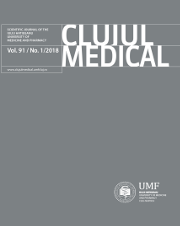Outcomes of robotic-assisted radical prostatectomy for patients in two extreme age-groups (< 50 years vs > 65 years)
DOI:
https://doi.org/10.15386/cjmed-825Keywords:
prostate cancer, prostatectomy, robotic surgical procedures, erectile functionAbstract
Background and aims. To assess the outcomes of robotic radical prostatectomy in two different age subgroups of pre-operatively potent patients: younger than 50 years and older than 65 years.
Methods. We included in the present study a number of 202 patients with prostate cancer divided into two groups: 99 patients older than 65 years (group 1) and 103 patients younger than 50 years (group 2).
Results. More than half of the younger patients were low-risk vs 57% of the older patients who were high-risk. Overall positive surgical margins rate was 21.2% in group 1 vs 12.1% in group 2. The early biochemical recurrence at 6 months after radical prostatectomy was 4% in group 1 vs 11.6% in group 2. The continence rate at 6 months was similar between the two groups and was not correlated with the patients’ age (p=0.72), nerve-sparing (p=0.3 for group 1, p=0.92 for group 2) or pathological staging (overall p=0.81, p=0.89 in group 1 and p=0.63 in group 2). We observed a significantly higher rate of potency for patients in group 2 (91.5% vs 47.2%, p<0.0001). The most important factor associated with the regain of potency at 6 months after the procedure was the age of the patient (p<0.0001), independently of the type of nerve-sparing performed.
Conclusions. Age seems to be the most important predictor of the regain of potency after robotic radical prostatectomy. Patients should be counseled accordingly in order to have realistic expectations about the functional results after robotic-assisted surgery.
Downloads
Additional Files
Published
How to Cite
Issue
Section
License
The authors are required to transfer the copyright of the published paper to the journal. This is done by agreeing to sign the Copyright Assignment Form. Whenever the case, authors are also required to send permissions to reproduce material (such as illustrations) from the copyright holder.

The papers published in the journal are licensed under a Creative Commons Attribution-NonCommercial-NoDerivatives 4.0 International License.

